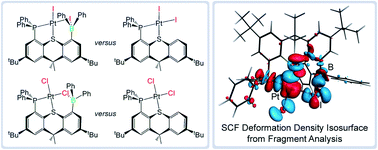Reaction of [PtCl2(COD)] and [PtI2(COD)] with 2,7-di-tert-butyl-5-diphenylboryl-4-diphenylphosphino-9,9-dimethylthioxanthene (TXPB) afforded square planar [PtCl2(TXPB)] (1B) and [PtI2(TXPB)] (4B), both of which were crystallographically characterized. Single-crystal X-ray quality crystals were also obtained for [PdCl2(TXPB)] (2B; Emslie et al., Organometallics, 2008, 27, 5317) as 2B·2CH2Cl2 and solvent-free 2B. Both the chloro and iodo TXPB complexes exhibit metal–halide–borane bridging interactions similar to those in previously reported [RhCl(CO)(TXPB)] (3B) and [RhI(CO)(TXPB)] (5B) (Emslie et al., Organometallics, 2006, 25, 583 and Inorg. Chem., 2010, 49, 4060). To facilitate a more detailed analysis of M–X–BR3 (X = Cl and I) interactions, a borane-free analogue of the TXPB ligand, 2,7-di-tert-butyl-4-diphenylphosphino-9,9-dimethylthioxanthene (TXPH), was prepared. Reaction with [PtX2(COD)] (X = Cl or I), [PdCl2(COD)] and 0.5 [{RhCl(CO)2}2] provided square planar [PtCl2(TXPH)] (1H), [PdCl2(TXPH)] (2H), [RhCl(CO)(TXPH)] (3H) and [PtI2(TXPH)] (4H). M–Cl–BR3 and M–I–BR3 bonding in 1B–5B was then probed through the use of structural comparisons, IR and NMR spectroscopy, cyclic voltammetry, and DFT calculations (Slater-type orbitals, Mayer bond orders, Hirshfeld charges, fragment analysis, SCF deformation density isosurfaces, and energy decomposition analysis).


 Please wait while we load your content...
Please wait while we load your content...